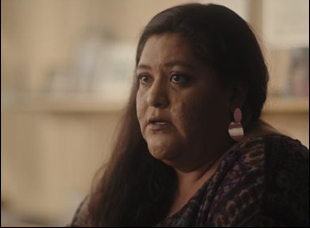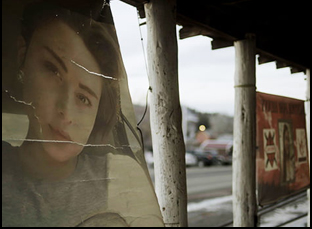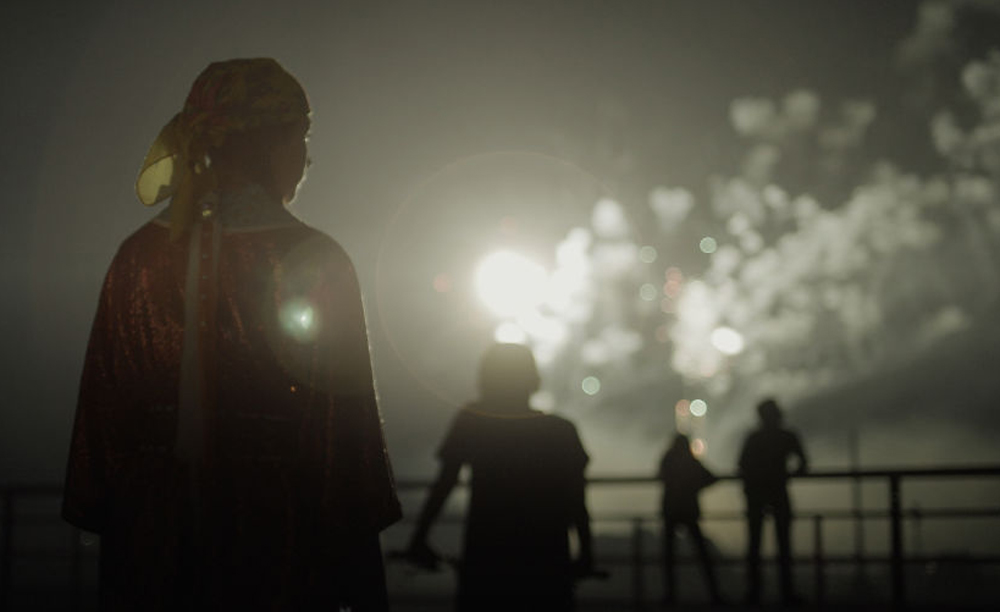“This is the most dangerous place for women in the country,” Luella Brien can be heard saying as she drives into work in Big Horn County, Montana, an area divided into various jurisdictions with territory belonging to the Crow and Northern Cheyenne people as well as the U.S. government via the city of Billings. The split has honored the sovereignty of the indigenous people yet separation of land has come at a considerable – and ongoing – cost when Interstate 90, the highway that runs between them has become a thoroughfare for trafficking Native women and potential kidnappers and murderers can act with impunity, seemingly aware that they can act with impunity when there’s little cooperation between tribal law enforcement and the FBI.
Brien couldn’t possibly fill the void that’s been left by this systemic failure to investigate the ever-growing number of cases, but she also can’t sit idly by, seeking to put together pieces have long gone unreconciled due to apathy on the part of the local authorities and as co-directors Razelle Benally and Matthew Galkin find in the new series “Murder in Big Horn,” which recently made its premiere at Sundance, it isn’t that she is alone in seeking justice, but corralling the political will to even start searching is as elusive as the women they seek to find. Over the course of three episodes, Benally and Galkin look into the cases of Henny Scott, Selena Not Afraid and Kaysera Stops Pretty Places, all teenagers who vanished separately after a night out with friends. It isn’t just the circumstances of their disappearance that is similar, but how it seems to be an echo of history that has repeated itself since European colonizers first encroached on Native land, aiming to demoralize the indigenous community by targeting young women for rape and assault.
Although Selena Not Afraid’s case galvanized the Murdered and Missing Indigenous Women’s movement to raise awareness of this ongoing tragedy, one that continues on even after death when most women that are found murdered are said to die by hypothermia when found out in the middle of nowhere rather than by someone else’s hand, “Murder in Big Horn” takes full advantage of the national platform it will be presented on, laying out the facts with Brien and others in the community to counter the historical erasure they’ve experienced when their testimony simply can’t be denied. After turning heads at Sundance, the series begins airing tonight on Showtime and will stream thereafter on Paramount+ and Benally, a filmmaker with roots in the Oglala Lakota/Diné community, and Galkin, who previously was a producer on the network’s “Murder in the Bayou” series, spoke about forging a partnership on the project, subverting expectations of the true crime genre, and earning the trust of locals that had taken issue with how they’ve been portrayed in the past.

Razelle Benally: When Matthew approached me about possibly directing this with him, I was obviously taken aback, but one of the things that really struck me from the way he was explaining things and I really felt not only just from him, but through intention [was how] I felt respected, first of all, but also this would be a great opportunity to do something more and to create an allyship. [The collaboration] really just worked. Cinematically and narrative-wise, we saw eye to eye on how to present this complex issue to the world, but we come from vastly different backgrounds and that was so imperative to being able to do this in the way that we did it.
It’s clear that a lot of trust has been lost between the community and anyone who shows up wanting to tell their story because of a lack of sensitivity about how these cases have been presented in the past. Did you find that was an obstacle for you?
Matthew Galkin: I certainly think as a white man and rightfully so, if I went in there alone, no one would’ve trusted me, and Razelle is so effortlessly grounded and a charming human, that certainly helped a lot in meeting these families. Some of them have been burned by the media and you know how the media [will] jump in and jump out — they write their story in a day and they leave. We wanted to do something different. We wanted to take the time to do it correctly.
Razelle Benally: Yeah, as a Native person, it was very easy to talk with these families and present what we’re doing in a way that was culturally appropriate, along with [producers] Ivy and Ivan [MacDonald], and they trusted us because we had key roles in the production. We weren’t consultants. We weren’t production assistants, we were the director, we were the producers, so when community members were like, “Okay, these folks are in charge and they are us and they want to do it right, of course we want to be a part of it.”
There’s unfortunately such a vast history to draw on for this, was it difficult to decide what cases to focus on?
Matthew Galkin: There were numerous factors that went into the decision of why [we chose] Big Horn County, Montana and these particular cases, one of which [was] right out of the gate, we knew we wanted to put a human face on this issue. We didn’t want to make a series about [Missing and Murdered Indigenous Women] as an issue. It wasn’t a topic-based exercise. We wanted to tell a human story, so we wanted to do that through cases and Big Horn County, Montana has one of the biggest concentrations of MMIW cases in the country. The families that live there that unfortunately have gone through this were some of the key instrumental people in advocating for their daughters and their sisters to such an extent that it actually put MMIW on the map nationally, so not only were we able to explore these cases and the lack of investigations and all of the issues that are going on there, but we were able to tell a bigger story about MMIW and the growth of the movement all the way up to the current cabinet in the United States Government.

Razelle Benally: She was never originally supposed to be a main through line, but upon first meeting her, we immediately saw how valuable she was, not just as a community member but as a storyteller herself in all the work that she was doing with Big Horn County News at that time to starting her own media company, she had a lot to say and she really helped coalesce the stories together. It really helped us to smoothly segue from episode to episode.
Matthew Galkin: Yeah, she had a lot to say and as a journalist, she was able to not only communicate her personal tragedy with this issue, but she also had perspective in the way that maybe some other people in the community didn’t on the holistic issue. We knew that we wanted to keep community at the center of the series and local media is certainly one aspect of community, so she also represented that. We feel very fortunate to have met her so early in our film. The interview at Big Horn News was the first shoot we ever did, so it really set the stage for a lot of what came after that.
When this is a small community, you see a number of people throughout the series who almost have to disassociate their professional lives from their personal ones, which is particularly striking in the case of Leroy Not Afraid, whose daughter Selena is one of the missing and now works in law enforcement. Was that a tension you encountered throughout?
Razelle Benally: Definitely, conversations came up about the sensitivities of this being a small community and opening up these issues to the entire world. Matthew can speak to more about the law enforcement side and how difficult that was to chase people down to interview that didn’t want to talk to media.
Matthew Galkin: Yeah, law enforcement was a huge challenge on this project. We invited the Big Horn County Sheriff’s office in because we were trying to make a series about a community, and not only are they a huge part of the community, but the dynamics between the families and law enforcement are very fraught and we spent over a year trying to get the Big Horn County Sheriff’s office to try to talk to us and when they wouldn’t, we were stunned when Leroy, who by that point had become the communications conduit for the Sheriff’s Office, reached out on his own accord. He said, “I can’t do [an interview] as the Undersheriff of Big Horn Country, but I can do it as Selena’s father.” That was nothing we had ever planned for. Obviously we filmed that and we also filmed with the ex-Undersheriff Eric Windburn, only because he had moved to Idaho at the time and was not fearful of the retribution that would befall him from the Sheriff’s Office if he still lived in the state of Montana.
It isn’t a true crime series, but clearly has that hook. Was that something to consider in the edit, avoiding some of those tropes?
Matthew Galkin: We knew going in what the optics would be, at least at the beginning of the series, which is that this is a true crime series on a native American reservation. That was the baseline pitch out to the world. But we knew obviously there’s a much, much bigger story to tell here and we were interested in telling it and we had the space to do it. Showtime was an amazing partner. They gave us a huge creative swath to work on and the time that we needed to do a true deep dive. Ultimately, we very consciously utilized the tropes of true crime to hook people into this story in an almost bait-and-switch kind of way [where] these cases will probably never be solved, but that’s never the point of our series. We’re not private investigators or trained law enforcement. We’re filmmakers and our job is to tell the story that we find and that’s the story that we found.
Razelle Benally: And the basic devices of true crime are this notion of a single perpetrator or maybe a group of perpetrators and there are clues, right? There’s an answer at the end. This can’t be a true crime genre series because we don’t have a single perpetrator. These cases aren’t serial in the sense that just one person is doing them, and yes, there may be clues, but as you can see through the series, Luella is investigating what little clues there are and you start to learn that the crimes are colonization along with law enforcement negligence and jurisdictional loopholes and so on and so forth.
“Murder in Big Horn” premieres on Showtime on February 3rd and will stream thereafter on Paramount+.




